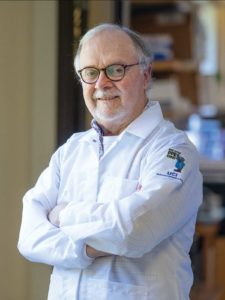

MAPPING THE HUMAN BRAIN
Xiangmin Xu leads a UCI interdisciplinary team – including neuroscientists, engineers, virologists, computer scientists and mathematicians – that is raising new hope for early treatments of crippling brain disorders such as Alzheimer’s, depression and epilepsy. In September, Xu’s Center for Neural Circuit Mapping began collaborating with two other institutions on a five-year project, backed by $126 million in federal funds, to map the human brain in unprecedented molecular detail.
“What is most exciting about our work is that we have the potential to identify early warning signs of disorders such as Alzheimer’s disease when they are still treatable,” he says.
In a key breakthrough, Xu, a professor in the Department of Anatomy and Neurobiology, says he and his collaborators have already discovered ways to reopen windows of neural development in adults, paving the way for previously unthinkable remedies.
LAYING THE GROUNDWORK FOR RNA VACCINES
With life approaching a pre-pandemic norm, Philip Felgner is feeling justifiably proud.
Felgner, 72, UCI’s director of Vaccine Research and Development Center, has spent more than half of his lifetime helping to lay the groundwork for the cutting-edge messenger RNA vaccines that have saved countless lives.
Older vaccines stimulated the body’s immune system with weak or inactive viruses or bacteria. The game-changing new vaccines deployed in the pandemic instead use genetically engineered mRNA to teach cells to make a protein that triggers an immune response.
Felgner’s contributions date to his 1984 discovery of lipofection technology, in which scientists insert genetic material into a liposome – an artificial nanoparticle – to deliver it to cells. Since then, hundreds of other researchers have helped develop the field.
Last year, Felgner was one of seven scientists to win Spain’s prestigious Princess of Asturias Award, but he isn’t resting on his laurels. At the start of the pandemic, in February 2020, his lab began monitoring local virus exposure and later measured the stunning efficacy of the mRNA vaccines.
“My proudest moment is now,” he says, “to see the results of my contribution and those of hundreds of other scientists come to fruition in such a dramatic way.”